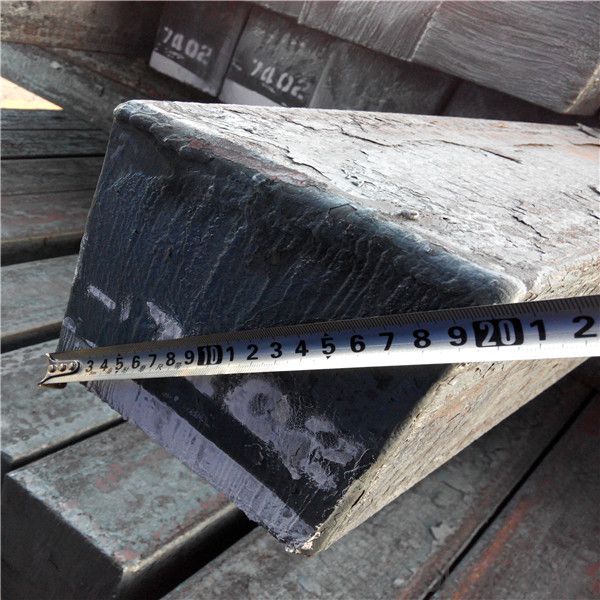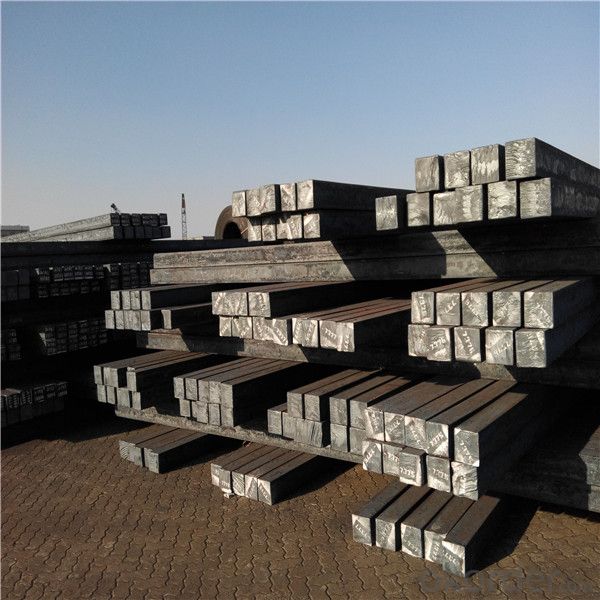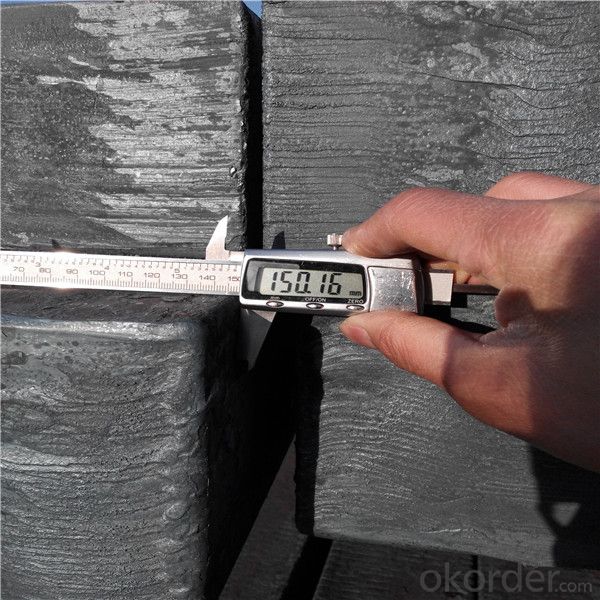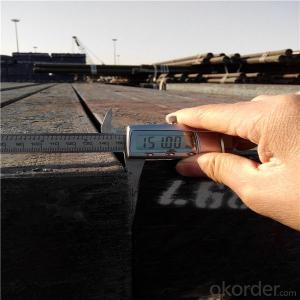150X150 square steel billets low carbon
- Loading Port:
- China main port
- Payment Terms:
- TT OR LC
- Min Order Qty:
- 1000 m.t.
- Supply Capability:
- 14263 m.t./month
OKorder Service Pledge
OKorder Financial Service
You Might Also Like
Item specifice
Billet:
Used for the plant, the bridge,shipment building high rise building construction,lifting and transportation machinery, equipment manufracturing base building
the support foundation pile manufacturing.
Billets, or ingots (as they sometimes referred to), are not of practical use until they have been formed
into more functional shapes and sizes. While they have already been put in the furnace, they still require
a series of shaping and molding procedures such as hot and cold working, milling and cutting before they
are sold in hardware stores, or used for different applications. The unformed billets, however, can be used
in striking currency such as coins and as reserves, similar to gold bars.
Gade:
Standard | C(%) | Mn(%) | S(%) | P(%) | Si(%) |
Q195 | ≤0.12 | ≤0.50 | ≤0.040 | ≤0.035 | ≤0.30 |
Q235 | ≤0.20 | ≤1.40 | ≤0.045 | ≤0.045 | ≤0.35 |
Q275 | ≤0.22 | ≤1.50 | ≤0.045 | ≤0.045 | ≤0.35 |
20MnSi | 0.17-0.25 | 1.2-1.6 | ≤ 0.050 | ≤ 0.050 | 0.40-0.80 |
3SP | 0.14-0.22 | 0.40-0.85 | ≤ 0.050 | ≤ 0.040 | 0.05-0.15 |
5SP | 0.28-0.37 | 0.50-1.00 | ≤ 0.050 | ≤ 0.040 | 0.15-0.30 |




Our service :
We have a plant and professional team to provide our best service, from the start of production until the
loading into the vessel, we have a complete quality follow up procedure, to assure our products arrives to the customer with satisfaction. Welcome new and old customers
to contact us for future business relationships! We will give you a surpise price.
Packing :
Within 30 days
1.Standard export package
2.In bundles with steel strips
3.As the requirements of the customers
FAQ:
Q: What is payment terms?
A: FOB 30% T/T IN ADVANCE AS DEPOSIT AND 70% T/T BEFORE SHIPMENT
CIF and CFR 30% T/T IN ADVANCE AS DEPOSIT AND 70% T/T AS THE COPY OF B/L OR L/C AT SIGHT
Q:How to guarantee the quality of the products?
A:We have established the international advanced quality management system,every link from raw material
to final product we have strict quality test;We resolutely put an end to unqualified products flowing into the market.
At the same time, we will provide necessary follow-up service assurance.
Q:How long can we receive the product after purchase?
A :In the purchase of product within three working days, We will arrange the factory delivery as soon as possible.
The pecific time of receiving is related to the state and position of customers.
- Q:How are steel billets used in the production of oil and gas exploration equipment?
- Steel billets are commonly used in the production of oil and gas exploration equipment due to their strength and durability. These billets are shaped and machined into various components such as valves, pumps, drilling tools, and pipelines, which are crucial for the extraction and transportation of oil and gas. The high-quality steel ensures that the equipment can withstand harsh operating conditions, including high temperatures, pressure, and corrosive environments, thereby ensuring the safety and reliability of oil and gas exploration operations.
- Q:How are steel billets inspected for internal defects?
- Steel billets are inspected for internal defects using various non-destructive testing (NDT) techniques. One common method is ultrasonic testing (UT), where high-frequency sound waves are used to detect defects inside the billet. A transducer sends ultrasonic waves into the billet, and the reflected waves are analyzed to identify any internal flaws. UT is capable of detecting defects such as cracks, voids, inclusions, and other discontinuities. Another method employed is magnetic particle inspection (MPI). This technique is particularly useful for detecting surface and near-surface defects in ferromagnetic materials like steel. A magnetic field is applied to the billet, and iron particles are spread over the surface. If there is a defect, the magnetic field will cause the particles to form visible indications, providing a clear indication of any internal flaws. Liquid penetrant testing (PT) is another widely used method for inspecting steel billets. In this process, a liquid dye is applied to the surface of the billet and allowed to penetrate any surface-breaking defects. After a specified time, excess dye is removed, and a developer is applied. The developer draws out the penetrant from any defects, making them visible under proper lighting conditions. Additionally, radiographic testing (RT) can be employed to detect internal defects in steel billets. This method uses X-rays or gamma rays to capture images of the billet's internal structure. The radiation passes through the billet, and a film or digital detector records the transmitted radiation. Any internal defects will appear as shadows on the image, allowing for their identification. Overall, a combination of these NDT techniques is often used to ensure thorough inspection of steel billets for internal defects. This helps maintain the quality and integrity of the billets, ensuring they meet the required specifications and standards.
- Q:What are the different types of steel billet extrusion processes?
- There are several different types of steel billet extrusion processes used in the manufacturing industry. These processes involve shaping a solid steel billet into a desired profile or shape by applying high pressure. 1. Direct Extrusion: This is the most common type of steel billet extrusion process. In this method, the billet is placed inside a container called a "container" or "container die." The container has a small opening called a "die" through which the billet is forced using a ram or a piston. The steel billet is pushed through the die, and the resulting shape is formed. 2. Indirect Extrusion: In this process, the container die is stationary, and the billet is pushed through the die using a punch or a ram. The billet is placed inside a hollow chamber called a "container" or "container die" with a smaller diameter opening at one end. The punch is then used to apply pressure on the billet, forcing it to flow through the die and take the shape of the desired profile. 3. Impact Extrusion: This process is similar to direct extrusion, but it involves using a punch with a specially designed shape. The punch strikes the billet with a high impact force, causing it to flow and take the shape of the die. Impact extrusion is commonly used for producing small, intricate shapes with thin walls. 4. Hydrostatic Extrusion: In this process, the billet is placed inside a sealed chamber filled with a pressurized fluid, usually oil or water. The fluid pressure is applied to the billet, forcing it to flow through the die and take the desired shape. Hydrostatic extrusion is often used for producing complex shapes with high precision. 5. Cold Extrusion: This process involves extruding the steel billet at room temperature, without the need for heating. Cold extrusion is commonly used for producing small, intricate parts with high dimensional accuracy. It is a cost-effective method that allows for the production of parts with excellent surface finish. Each of these steel billet extrusion processes has its own advantages and limitations, and the choice of process depends on factors such as the desired shape, size, material properties, and production requirements.
- Q:What are the different types of steel billet rolling mill automation systems?
- There are several different types of steel billet rolling mill automation systems that are commonly used in the industry. These systems are designed to improve the efficiency, accuracy, and overall productivity of the rolling mill operations. Here are some of the most commonly used automation systems: 1. Level 1 Automation: This is the basic level of automation that includes basic control and monitoring functions. It typically involves the use of programmable logic controllers (PLCs) to control and monitor various aspects of the rolling mill, such as speed, temperature, and pressure. This level of automation provides basic functionality but may require manual intervention for certain tasks. 2. Level 2 Automation: This level of automation goes beyond the basic control and monitoring functions of level 1. It includes advanced process control algorithms and models to optimize the rolling mill operations. Level 2 automation systems can automatically adjust the mill parameters, such as roll gap, roll speed, and cooling water flow, to achieve the desired product specifications. These systems also provide real-time process monitoring and data analysis capabilities. 3. Level 3 Automation: This level of automation focuses on the integration of the rolling mill with other systems in the plant, such as the material handling system and the quality control system. It includes features like automatic scheduling, inventory management, and seamless data exchange between different systems. Level 3 automation systems enable better coordination and synchronization of the entire production process, resulting in improved efficiency and reduced downtime. 4. Artificial Intelligence (AI) and Machine Learning: Some advanced automation systems leverage AI and machine learning algorithms to continuously learn from the data collected during the rolling mill operations. These systems can predict equipment failures, optimize production parameters, and even suggest process improvements. AI and machine learning-based automation systems enable proactive maintenance, better decision-making, and increased overall productivity. 5. Robotics and Robotics-assisted Automation: In some steel billet rolling mills, robots are used for various tasks, such as loading and unloading, quality inspection, and maintenance. Robotic automation systems offer precision, speed, and repeatability, reducing the need for manual labor and improving safety. These systems can be integrated with other automation systems to create a fully automated and efficient rolling mill operation. Overall, the different types of steel billet rolling mill automation systems offer varying levels of functionality and sophistication. The choice of automation system depends on the specific requirements of the mill, the desired level of automation, and the available budget.
- Q:What are the causes of internal cracks in continuous casting billet?
- A French Research Institute of carbon, sulfur and phosphorus influence on continuous casting billet hot cracking, a total of three test groups of carbon manganese steel, carbon, sulfur and phosphorus content of each sample is different. The test according to the process of the sample for cooling, in order to study the effects of the three elements of the internal crack of continuous casting billet hot.
- Q:What are the different types of casting processes used for shaping steel billets?
- There are several different types of casting processes used for shaping steel billets. These processes include: 1. Continuous Casting: This is the most commonly used method for casting steel billets. In this process, molten steel is poured into a water-cooled mold that is continuously moving. As the steel solidifies, it is continuously pulled out of the mold, resulting in a continuous billet. This process is efficient and allows for high production rates. 2. Centrifugal Casting: In this process, molten steel is poured into a rotating mold. The centrifugal force generated by the rotation distributes the molten metal evenly along the mold walls, resulting in a cylindrical billet. This method is used to produce high-quality and defect-free billets. 3. Ingot Casting: This is a traditional method of casting steel billets. In this process, molten steel is poured into a mold and allowed to solidify. The solidified steel, known as an ingot, is then removed from the mold and further processed to obtain the desired shape of the billet. Ingot casting allows for flexibility in terms of billet shape and size. 4. Sand Casting: This process is used for producing large and complex steel billets. It involves creating a mold using a mixture of sand and a binder material. Molten steel is then poured into the mold, and once it solidifies, the mold is removed to reveal the billet. Sand casting allows for the production of custom-shaped billets but is a slower and less precise process compared to others. 5. Investment Casting: Also known as lost-wax casting, this process is suitable for complex and intricate shapes. In investment casting, a wax pattern of the desired billet shape is created. The wax pattern is then coated with a ceramic shell, and the wax is melted out, leaving behind a hollow mold. Molten steel is poured into the mold, and once it solidifies, the ceramic shell is broken to retrieve the billet. Each of these casting processes has its advantages and disadvantages, and the choice of process depends on factors such as the desired billet shape, size, production volume, and quality requirements.
- Q:What are the different machining processes for steel billets?
- There are several machining processes that can be used for steel billets, depending on the desired outcome. Some common machining processes for steel billets include turning, milling, drilling, and grinding. Turning involves rotating the billet against a cutting tool to remove material and create a desired shape. Milling involves using a rotating cutter to remove material from the billet, typically in a perpendicular or angled direction. Drilling involves creating holes in the billet using a drill bit. Grinding involves using an abrasive wheel to remove material and create a smooth surface finish on the billet. These machining processes can be combined or used individually to achieve the desired shape, dimensions, and surface finish for the steel billet.
- Q:How are steel billets unloaded at the destination?
- Steel billets are typically unloaded at the destination using heavy machinery such as cranes or forklifts. These machines carefully lift and transport the steel billets from the transport vehicle to the designated storage area.
- Q:How do steel billets contribute to the manufacturing of furniture?
- The manufacturing of furniture relies heavily on steel billets, which serve as the essential raw material needed to create strong and durable frames. These billets, produced through casting or hot rolling, are semi-finished steel products with a rectangular shape. After obtaining the steel billets, they can undergo various manufacturing techniques such as forging, extrusion, or machining to shape them into different furniture components. These components include frames for chairs, tables, beds, and other elements that require stability and strength. Using steel billets in furniture manufacturing offers several advantages. Firstly, steel is renowned for its exceptional strength and durability, making it an ideal material for furniture that can handle heavy loads and regular use. By utilizing steel billets, the furniture becomes robust and long-lasting, reducing the need for frequent replacements. In addition, steel billets provide design flexibility as they can be easily molded and shaped into different forms. This allows furniture manufacturers to create intricate and unique designs that meet customers' aesthetic preferences. Moreover, steel billets can be seamlessly welded, resulting in a more cohesive and visually appealing final product. Furthermore, steel is highly resistant to corrosion, which is crucial for furniture that may be exposed to moisture or environmental factors. By incorporating steel billets, the furniture remains free from corrosion, preserving its appearance and structural integrity over time. In conclusion, steel billets are indispensable in furniture manufacturing as they provide the necessary strength, durability, and flexibility to create sturdy frames and structural components. Their utilization enables furniture manufacturers to produce high-quality products that are long-lasting, visually appealing, and resistant to corrosion.
- Q:For example, screw plate (PU plate and manganese plate), carbon steel Primeton is what person rolling out?.
- that in addition to the carbon and other elements, such as Cr, Mo etc., in which the carbon ratio below 30 for low alloy steel
1. Manufacturer Overview |
|
|---|---|
| Location | |
| Year Established | |
| Annual Output Value | |
| Main Markets | |
| Company Certifications | |
2. Manufacturer Certificates |
|
|---|---|
| a) Certification Name | |
| Range | |
| Reference | |
| Validity Period | |
3. Manufacturer Capability |
|
|---|---|
| a)Trade Capacity | |
| Nearest Port | |
| Export Percentage | |
| No.of Employees in Trade Department | |
| Language Spoken: | |
| b)Factory Information | |
| Factory Size: | |
| No. of Production Lines | |
| Contract Manufacturing | |
| Product Price Range | |
Send your message to us
150X150 square steel billets low carbon
- Loading Port:
- China main port
- Payment Terms:
- TT OR LC
- Min Order Qty:
- 1000 m.t.
- Supply Capability:
- 14263 m.t./month
OKorder Service Pledge
OKorder Financial Service
Similar products
New products
Hot products
Related keywords





























